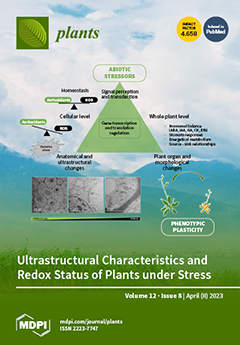Sweet potatoes (
Ipomoea batatas) are one of the important tuberous root crops cultivated worldwide, and thier storage roots are rich in antioxidants, such as anthocyanins.
R2R3-MYB is a large gene family involved in various biological processes, including anthocyanin biosynthesis. However, few reports about the
R2R3-MYB gene family of sweet potatoes have been released to date. In the present study, a total of 695 typical
R2R3-MYB genes were identified in six
Ipomoea species, including 131
R2R3-MYB genes in sweet potatoes. A maximum likelihood phylogenetic analysis divided these genes into 36 clades, referring to the classification of 126 R2R3-MYB proteins of Arabidopsis. Clade C25(S12) has no members in six
Ipomoea species, whereas four clades (i.e., clade C21, C26, C30, and C36), including 102 members, had no members in Arabidopsis, and they were identified as
Ipomoea-specific clades. The identified
R2R3-MYB genes were unevenly distributed on all chromosomes in six
Ipomoea species genomes, and the collinearity analysis among hexaploid
I. batatas and another five diploid
Ipomoea species suggested that the sweet potato genome might have undergone a larger chromosome rearrangement during the evolution process. Further analyses of gene duplication events showed that whole-genome duplication, transposed duplication, and dispersed duplication events were the primary forces driving the
R2R3-MYB gene family expansion of
Ipomoea plants, and these duplicated genes experienced strong purifying selection because of their Ka/Ks ratio, which is less than 1. Additionally, the genomic sequence length of 131
IbR2R3-MYBs varied from 923 bp to ~12.9 kb with a mean of ~2.6 kb, and most of them had more than three exons. The Motif 1, 2, 3, and 4 formed typical R2 and R3 domains and were identified in all IbR2R3-MYB proteins. Finally, based on multiple RNA-seq datasets, two
IbR2R3-MYB genes (
IbMYB1/g17138.t1 and
IbMYB113/g17108.t1) were relatively highly expressed in pigmented leaves and tuberous root flesh and skin, respectively; thus, they were identified to regulate tissue-specific anthocyanin accumulation in sweet potato. This study provides a basis for the evolution and function of the
R2R3-MYB gene family in sweet potatoes and five other
Ipomoea species.
Full article






